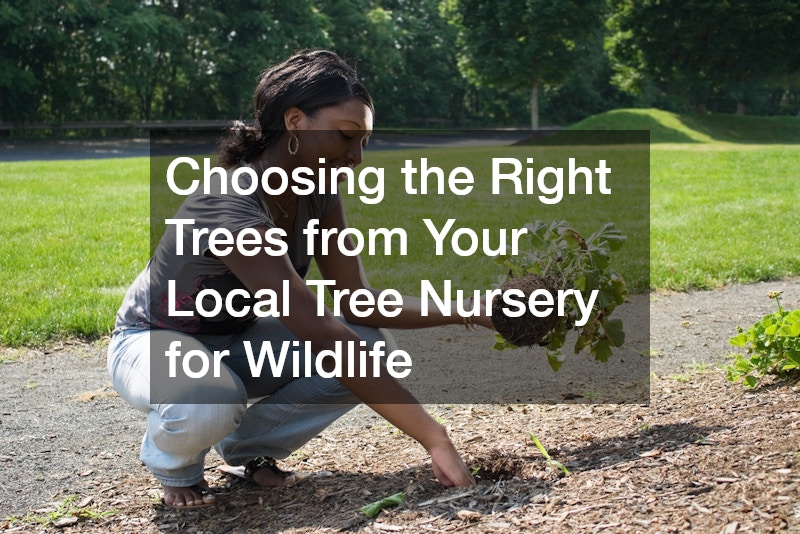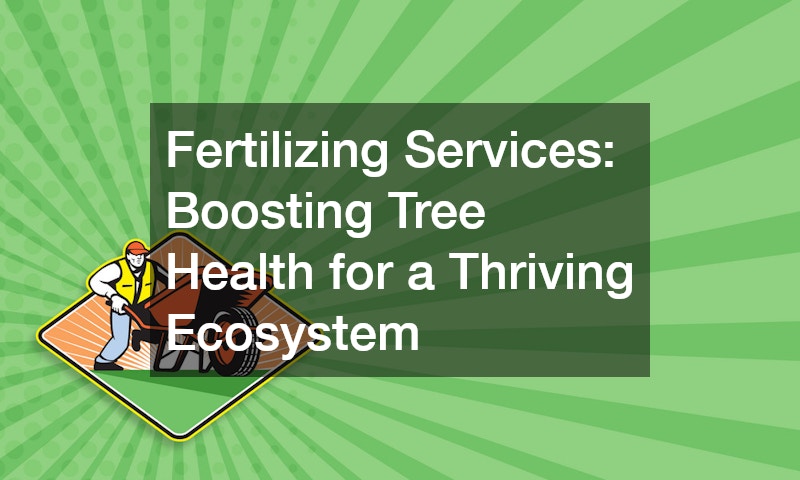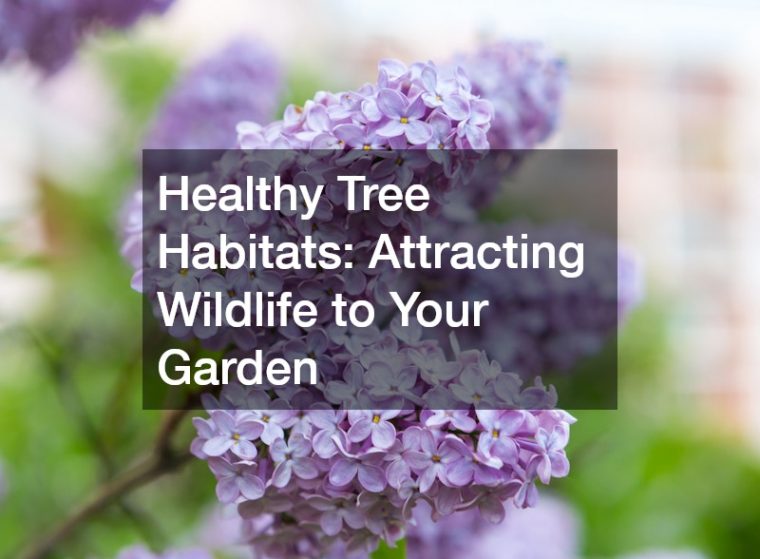
Creating a garden that supports local wildlife involves more than just planting a few trees and flowers. It’s about understanding the intricate relationship between native trees and the creatures that call them home. This article explores various ways to choose and manage trees to foster biodiversity while maintaining a healthy tree population.
A key factor in wildlife conservation is recognizing the significance of healthy tree ecosystems. Healthy trees not only offer shelter and food but also sustain the broader ecological network. Through deliberate choices and practices, homeowners can transform their backyards into thriving sanctuaries for wildlife.
In the following sections, we will delve deep into the methodologies required to achieve this balance. From selecting the right trees at your local tree nursery to working with professional tree services, every step is crucial in supporting a vibrant wildlife habitat right in your backyard.
Choosing the Right Trees from Your Local Tree Nursery for Wildlife

When it comes to selecting trees from a local tree nursery, it is crucial to focus on native species. Native trees have evolved alongside local wildlife, providing the best resources for food and habitat. Ensuring you choose the right species involves assessing the needs of both the flora and fauna in the surrounding area.
Consulting experts at your local tree nursery can help you understand which trees thrive in your region’s climate. By selecting trees suited to your local weather and soil conditions, you improve the chances of maintaining a healthy tree. Experts can guide you towards varieties that require minimal intervention and provide the greatest ecological benefits.
Additionally, balance is key. Mixing different tree species can help create a landscape that supports a wider range of wildlife. A diverse selection will support various insects, birds, and mammals, enhancing the ecological integrity of your green space.
Landscaping with Purpose: Designing a Habitat That Attracts Wildlife
When landscaping with a purpose, the primary goal is to create an environment that naturally attracts and supports wildlife. It starts with an appreciation for the role of healthy trees in the ecosystem. The selection and placement of trees should be strategic, looking to mimic natural habitats as closely as possible.
Creating layers within your garden can stimulate a rich habitat. This includes ground covers, shrubs, medium trees, and canopy trees. Every layer serves a unique purpose, accommodating diverse wildlife while nurturing healthy tree ecosystems.
It’s vital to integrate plants that are food sources for the species you wish to attract. This involves planting fruit-bearing trees, utilizing native species from the tree nursery, and creating dense thickets that offer sanctuary for nesting or foraging wildlife.
How Tree Services Can Help Create Healthy Tree Habitats in Your Garden

Partnering with professional tree services can provide invaluable assistance in maintaining healthy tree habitats. Professional arborists offer expertise in tree health assessments, ensuring that your plants are in the best condition to support local wildlife. Through their services, disorders can be detected and addressed before they become severe.
Regular tree maintenance work performed by tree services includes routine pruning, which promotes growth and reduces disease susceptibility. Proper pruning techniques are essential not only for maintaining tree health but also for shaping the canopy to enhance aesthetic and wildlife benefits.
Tree services can also advise on optimal tree placement and species diversity, contributing to a robust ecosystem. Their involvement ensures that you develop and sustain a garden that continually meets the needs of both the trees and the wildlife they support.
The Role of Tree Companies in Supporting Local Wildlife Conservation
Tree companies play a vital role in assisting homeowners and communities with local wildlife conservation efforts. By offering a range of services focused on tree health and maintenance, they help preserve the delicate balance between urban development and ecological sustainability. Their commitment extends beyond the individual client, contributing to larger community conservation goals.
Through comprehensive support, tree companies are invaluable in addressing large-scale conservation projects. Their ability to perform local tree removal in a manner that considers surrounding flora and fauna ensures minimal disruption to wildlife habitats. This responsibility ensures that the necessary actions taken in tree removal do not have a lasting negative impact on ecosystems.
Moreover, collaboration between tree companies and conservation groups enhances educational outreach. Their joint efforts help inform communities about the importance of biodiversity and the role of healthy tree populations in fostering thriving landscapes.
Fertilizing Services: Boosting Tree Health for a Thriving Ecosystem

Effective fertilizing services are crucial for ensuring tree health and by extension, fostering an ecosystem ready for wildlife. Proper nutrient management supports robust tree growth, compensating for deficits in urban and suburban soils that might hinder development. A healthy tree is not just more resilient to disease, but also more inviting to wildlife.
Fertilizing services provide tailored solutions that supplement soil fertility, addressing specific deficiencies and improving plant vigor. Balanced nutrients help foster strong roots, which are necessary for uptake of water and minerals, contributing to overall health and stability.
By promoting optimal growth conditions through fertilization, landowners can support diverse ecosystems. A well-nourished tree can offer shelter, food sources, and breeding sites for multiple species, thus enhancing the ecological diversity of your garden.
Landscapes That Support Wildlife: Best Practices for Gardeners
There are certain best practices that gardeners can follow to ensure landscapes support wildlife sustainably. Starting with healthy tree choices and enhancing the soil with native plants is a strong foundation. Incorporating a variety of plant types will invite different species of wildlife into the garden.
Gardeners should focus on preserving naturally available resources such as water bodies, rocks, and dead trees, which offer valuable habitat features. Incorporating these elements enhances habitat complexity and supports wider food webs. These practices combined help create a self-sustaining environment that continually supports its inhabitants.
Another crucial aspect is reducing chemical inputs. By minimizing pesticides and opting for natural pest control methods, gardeners can reduce harm to non-target species. This approach leads to a healthier garden ecosystem and contributes to the persistence of biodiversity.
Using Bark Blowing to Enhance Soil Quality Around Your Trees
Bark blowing is an innovative technique that involves the application of bark mulch around tree bases for improved soil quality. This technique offers several advantages in promoting tree health, such as soil moisture retention and temperature regulation. Healthy soil, fostered by bark blowing, leads to healthy trees, which in turn support a broad range of wildlife.
The benefits of bark blowing extend beyond soil improvement; it reduces weeds and prevents soil erosion. By promoting stable, nutrient-rich environments, trees can grow more robustly and support thriving under-canopy ecosystems, increasing plant and animal diversity.
Additionally, the use of organic materials within bark blowing assists in the gradual decomposition process, adding essential nutrients back into the soil. This creates a fertile environment that aids both in the immediate and long-term health of the trees, ensuring they remain strong fixtures in local ecosystems.
Pest Control Services: Protecting Your Healthy Trees from Harmful Insects
Pest control services are an essential aspect of maintaining healthy trees, especially in urban and suburban settings. These services help manage the balance between keeping tree populations strong while minimizing risks to the wildlife that depend on them. Proper pest management practices can mitigate damage without compromising the surrounding ecosystem.
Employing integrated pest management (IPM) is advisable as it focuses on long-term prevention and uses a combination of biological and mechanical controls. By choosing environmentally friendly pest control services, the chances of disrupting beneficial insect populations are minimized, allowing the ecosystem to maintain its biodiversity.
Healthy trees contribute significantly to sustainable gardens. When they are protected from pests, they can provide consistent food sources and habitats, ensuring local fauna can continue to thrive, even in managed urban landscapes.
Avoiding Wood Destroying Insects: Tips for Maintaining Tree Health
Wood-destroying insects, such as termites and beetles, can be incredibly detrimental to the health of trees and the ecosystem they support. Protecting trees from these insects involves a mix of proactive measures and careful monitoring. By maintaining vigorous, healthy tree conditions, such threats can often be mitigated.
Strategies for preventing infestations include proper sanitation and regular inspections. Removing infested wood promptly and sealing wounds can prevent wood destroying insects from gaining a foothold. Additionally, selecting disease- and pest-resistant tree varieties from your local tree nursery can further safeguard your garden’s health.
Natural predators and beneficial insects should also be encouraged, as they help maintain a balance, keeping harmful insect populations in check. Through vigilant care and monitoring, you can ensure that your garden remains a robust haven for both plants and wildlife.
Working with Landscaping Contractors to Design Wildlife-Friendly Spaces

Collaborating with experienced landscaping contractors offers homeowners the opportunity to design spaces that harmoniously merge aesthetic appeal with ecological function. Landscaping contractors have the know-how to create avian-friendly environments, using landscape designs that incorporate native flora and tree placements that protect against predators.
By utilizing input from professionals in the field, you can plan a more effective use of your space. They can direct the selection and placement of trees and shrubs to cater to specific wildlife needs. This results in a landscape that has both ecological diversity and visual harmony.
Landscaping contractors can assist in creating shelter belts or hedgerows, providing refuge and feeding grounds for wildlife. Their expertise ensures planting configurations that support local wildlife while complementing the surrounding urban or rural environment.
Tree Removal: When It’s Necessary and How It Affects Local Wildlife
Tree removal is sometimes an essential activity to ensure safety and the health of other plants. However, local tree removal can significantly disrupt wildlife habitats if not handled cautiously. By understanding when and how to perform tree removal, you can help lessen its negative impacts on the environment.
Local tree removal should be considered when trees pose a risk due to disease, structural compromise, or interference with essential utilities. Professional tree services keep removal safe and efficient, ensuring minimal disruption to the surrounding habitat. Proper planning allows for the safe relocation or support of affected wildlife species.
When tree removal is unavoidable, replanting with appropriate native species can quickly restore lost habitat. This transition helps maintain wildlife presence and supports continued biodiversity in the local ecosystem.
Creating a Diverse Landscape: Combining Trees and Plants for Biodiversity
A diverse landscape serves as a rich sanctuary for wildlife, and it begins with combining various plant types that include trees, shrubs, flowers, and vines. This combination helps establish a dynamic ecosystem where different species can find food and shelter. Encouraging biodiversity supports the vitality of all elements within the garden, from the soil microbiomes to the larger mammals that roam it.
When designing diverse landscapes, it’s essential to consider plant interactions, i.e., how certain combinations support growth or repel pests. This understanding can guide the selection process, ensuring that the layout promotes natural control over environmental pressures, thus fostering healthier tree populations.
Incorporating a range of pigmentations and flowering periods will invite a succession of pollinators, ensuring continuous wildlife visitation throughout the seasons. This vibrant landscaping approach promotes ecological integrity and aesthetic beauty.
Seasonal Tree Care: Essential Services for Maintaining Healthy Tree Habitats
Seasonal tree care is paramount in maintaining healthy tree habitats that continually support wildlife year-round. Each season brings unique challenges and opportunities for tree health maintenance, whether through pruning, fertilizing, or pest management services. Regular care can enhance your landscape’s resilience to various environmental stressors.
Spring and fall are typically ideal for planting and fertilizing services, capitalizing on moderate temperatures ideal for root development. Timely interventions ensure trees maintain vigorous growth before extreme weather, such as summer heat or winter frosts, can threaten their health.
Throughout seasonal changes, continual care ensures that trees are well-prepared to support local wildlife. By keeping trees healthy and robust, their role as a keystone species in the garden ecosystem is fully realized, enabling them to provide shelter, food, and protection for various animal species.
Understanding the intricate relationship between trees and wildlife is fundamental to cultivating a garden that fosters biodiversity and ecological health. By thoughtful tree selection, engaging professional tree services, and adhering to best practices, you are equipped to create an environment that celebrates natural diversity.
Healthy tree populations serve as the backbone of wildlife habitats, providing a foundation where ecosystems can flourish. Continually nurturing these landscapes will ensure sustainable coexistence between humans and wildlife.
This holistic approach strengthens both environmental and human communities, contributing to the preservation and enjoyment of natural spaces for generations to come. With dedicated effort and attention, an enriched, wildlife-friendly garden is well within reach.
